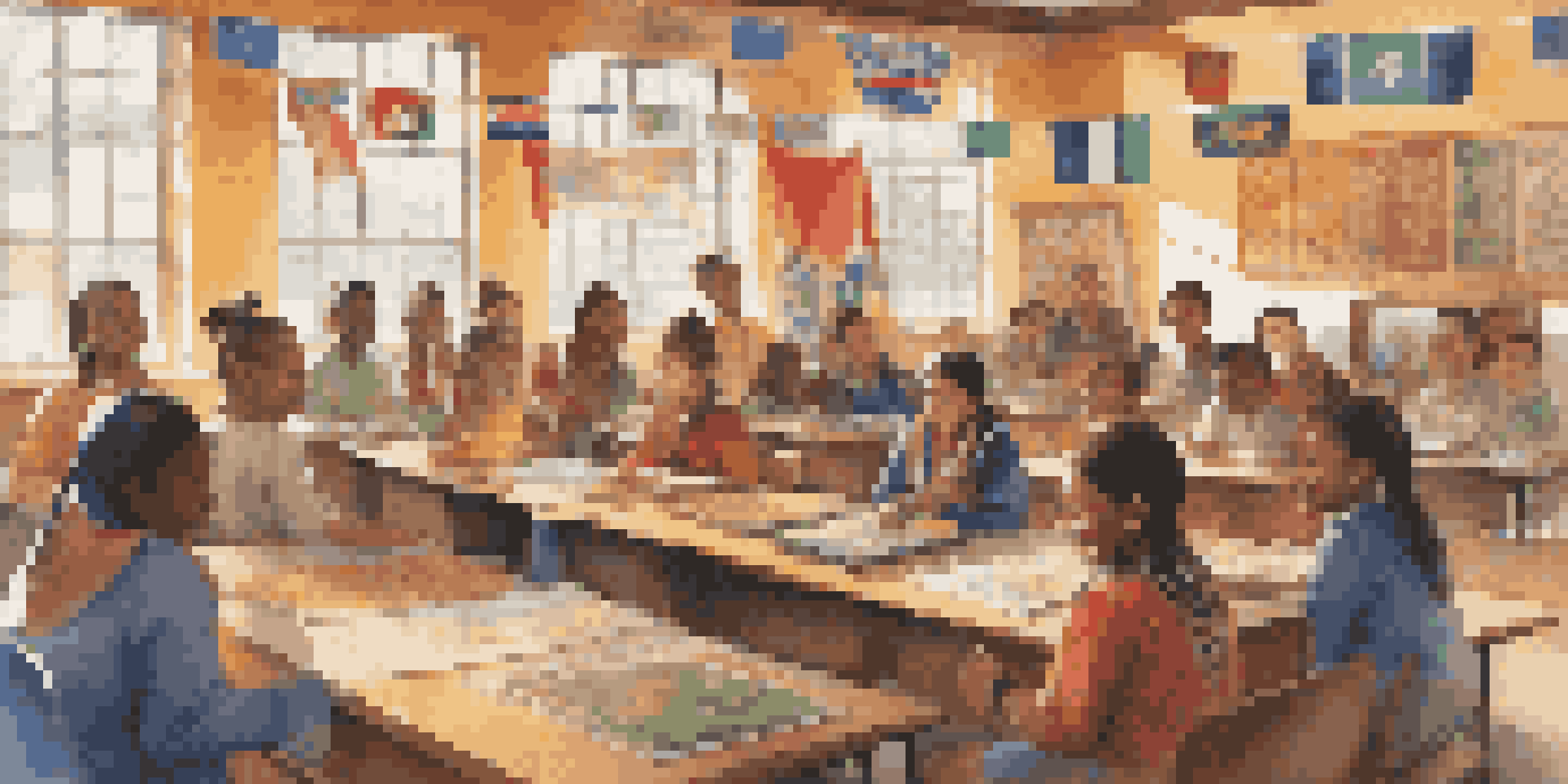Navigating Cultural Sensitivity in Curriculum Implementation

Understanding Cultural Sensitivity in Education
Cultural sensitivity in education means recognizing and respecting the diverse backgrounds of students. It involves understanding how cultural factors influence learning styles, communication preferences, and classroom dynamics. By prioritizing cultural sensitivity, educators can create an inclusive environment that fosters mutual respect among students.
Education is the most powerful weapon which you can use to change the world.
For instance, a classroom that acknowledges and celebrates different cultural traditions can encourage students to share their experiences. This not only enriches the learning experience but also helps students feel valued and understood. When students see their culture represented in the curriculum, it can boost their engagement and academic success.
Ultimately, understanding cultural sensitivity is the first step toward implementing a curriculum that meets the needs of all learners. It sets the foundation for thoughtful curriculum design that respects diversity while promoting equity in education.
Assessing the Cultural Landscape of Your Classroom
Before implementing a curriculum, it's crucial to assess the cultural landscape of your classroom. This means understanding the demographics of your students, including their cultural, ethnic, and linguistic backgrounds. Gathering this information can help you tailor the curriculum to better reflect and honor the identities of your learners.

You might consider conducting surveys or informal discussions to gather insights about your students' cultural backgrounds. This can be a great way to learn about their interests, values, and experiences. By doing so, you can identify areas where the curriculum may need to be adjusted to ensure it resonates with all students.
Cultural Sensitivity Enhances Learning
Recognizing and respecting diverse cultural backgrounds in education fosters an inclusive environment that boosts student engagement and academic success.
Additionally, engaging with families and communities can provide valuable perspectives. Building relationships with parents and guardians can enhance your understanding of their cultural expectations, leading to a more cohesive and culturally relevant curriculum.
Incorporating Diverse Perspectives in Curriculum Design
One of the most effective ways to promote cultural sensitivity is to incorporate diverse perspectives into your curriculum. This means integrating materials and resources that reflect various cultures, histories, and viewpoints. A curriculum that showcases a range of voices can help students appreciate the richness of diversity and foster critical thinking skills.
Diversity is not about how we differ. Diversity is about embracing one another's uniqueness.
For example, including literature from authors of different backgrounds can introduce students to new ideas and experiences. It allows them to see the world through different lenses and encourages empathy. By presenting multiple perspectives, you help students understand that there isn't a single narrative or truth.
Moreover, incorporating diverse perspectives can make lessons more engaging and relatable. When students see themselves and their cultures represented, they are more likely to connect with the content, leading to deeper learning and retention.
Creating an Inclusive Learning Environment
Creating an inclusive learning environment goes hand-in-hand with cultural sensitivity. This involves establishing classroom norms that promote respect, collaboration, and open dialogue. By fostering an atmosphere where all students feel safe and valued, you create a space where cultural differences can be celebrated.
Encouraging students to share their cultural experiences can enrich classroom discussions and help build a sense of community. For instance, you might organize cultural share days where students present about their heritage. This not only educates their peers but also empowers students to take pride in their backgrounds.
Involve Families for Curriculum Success
Engaging families and communities in the curriculum development process strengthens the connection between home and school, creating a more relevant educational experience.
Additionally, it's essential to address any instances of bias or discrimination promptly. By setting clear expectations for behavior and addressing issues as they arise, you demonstrate a commitment to maintaining an inclusive environment for all students.
Professional Development for Educators
Educators play a vital role in fostering cultural sensitivity, and ongoing professional development is key. Training sessions focused on cultural competence can equip teachers with the knowledge and skills needed to address diverse student needs effectively. This may include workshops on inclusive teaching strategies, anti-bias education, and culturally relevant pedagogy.
For example, professional development could cover strategies for differentiating instruction based on cultural learning styles. Understanding how culture impacts cognition can help educators tailor their teaching methods to better suit their students. This ongoing learning helps educators stay informed about best practices and emerging trends in culturally responsive education.
Furthermore, collaboration among educators can enhance cultural sensitivity initiatives. Sharing experiences and resources can provide a support network that fosters growth and innovation in teaching practices.
Evaluating Curriculum Effectiveness and Cultural Impact
Evaluating the effectiveness of a culturally sensitive curriculum is essential for continued improvement. This involves gathering feedback from students, parents, and educators to assess how well the curriculum addresses diverse needs. Surveys, focus groups, and assessments can provide insights into what's working and what needs adjustment.
For instance, you might analyze student performance data to identify patterns that reveal how cultural inclusivity impacts learning outcomes. If certain groups are excelling while others struggle, it could indicate areas where the curriculum needs to be refined. This ongoing evaluation process helps ensure that the curriculum remains relevant and effective for all students.
Ongoing Training for Educators Needed
Continuous professional development equips educators with the skills to effectively address diverse student needs and promote cultural sensitivity in the classroom.
Moreover, reflecting on cultural impact can lead to more meaningful engagement with the community. Celebrating successes and addressing challenges transparently fosters trust and collaboration between schools and families.
Engaging Families and Communities in Curriculum Development
Families and communities are integral to the success of a culturally sensitive curriculum. Engaging them in the curriculum development process can provide valuable insights and foster a sense of ownership. By inviting input from families, educators can create a curriculum that better reflects the community's values and expectations.
For example, organizing community forums or workshops can create opportunities for dialogue between educators and families. This collaboration can help bridge gaps between home and school, ensuring that the curriculum resonates with students' lived experiences. When families feel involved in the educational process, it strengthens the partnership between schools and the community.

Ultimately, fostering strong relationships with families and communities enhances the relevance and impact of the curriculum. By working together, educators and families can create a rich, culturally responsive educational experience for all students.